engine oil CADILLAC CT5 2023 User Guide
[x] Cancel search | Manufacturer: CADILLAC, Model Year: 2023, Model line: CT5, Model: CADILLAC CT5 2023Pages: 526, PDF Size: 6.85 MB
Page 268 of 526

Cadillac CT5 Owner Manual (GMNA-Localizing-U.S./Canada-16500419) -
2023 - CRC - 5/10/22
Driving and Operating 267
{Warning
Rocker extensions may
break under pressure,
resulting in property damage
or injury. Do not stand on
the rocker extension or use
it as a step.
{Warning
Rear end spoilers may break
under pressure, resulting in
property damage or injury.
Do not push the vehicle by
the spoiler or use the spoiler
as a handle.
Ignition Positions
The vehicle has an electronic
keyless ignition with
pushbutton start.
The Remote Key must be in
the vehicle for the system to
operate. If the pushbutton
start is not working, the
vehicle may be near a strong
radio antenna signal causing
interference to the Keyless
Access system. See Remote
Key Operation09.
To shift out of P (Park), the
vehicle must be on and the
brake pedal must be applied. Stopping the Engine/OFF (No
Indicator Lights) :
When the
vehicle is stopped, press
ENGINE START/STOP once to
turn the engine off.
If the vehicle is in P (Park), the
ignition will turn off, and
Retained Accessory
Power (RAP) will remain active.
See Retained Accessory
Power (RAP) 0273.
If the vehicle has an automatic
transmission, and is not in
P (Park), the ignition will return
to accessory mode and display
a message in the Driver
Information Center (DIC).
When the vehicle is shifted
into P (Park), the ignition
system will turn OFF.
If the vehicle has a manual
transmission and is stationary,
the ignition will turn off, and
Retained Accessory
Power (RAP) will remain active.
See Retained Accessory
Power (RAP) 0273.
Page 271 of 526

Cadillac CT5 Owner Manual (GMNA-Localizing-U.S./Canada-16500419) -
2023 - CRC - 5/10/22
270 Driving and Operating
If the remote key is not in
the vehicle, if there is
interference, or if the
remote key battery is low,
a Driver Information
Center (DIC) message will
display. See Remote Key
Operation09.
Caution
Cranking the engine for long
periods of time, by pressing
ENGINE START/STOP
immediately after cranking
has ended, can overheat and
damage the cranking motor,
and drain the battery. Wait
at least 15 seconds between
each try, to let the cranking
motor cool down.
2. If the engine does not start after five to 10 seconds,
especially in very cold
weather (below −18 °C or
0 °F), it could be flooded
with too much gasoline.
Try pushing the
accelerator pedal all the
way to the floor and hold it there, then press ENGINE
START/STOP for up to a
maximum of 15 seconds.
Wait at least 15 seconds
between each try, to allow
the cranking motor to cool
down. When the engine
starts, let go of the button
and the accelerator. If the
vehicle starts briefly but
then stops again, do the
same thing. This clears the
extra gasoline from the
engine. Do not race the
engine immediately after
starting it. Operate the
engine and transmission
gently until the oil warms
up and lubricates all
moving parts.
Stopping the Engine
If the vehicle has an automatic
transmission, move the shift
lever to P (Park) and press and
hold ENGINE START/STOP on
the instrument panel, until the
engine shuts off. If the shift
lever is not in P (Park), the
engine shuts off and the
ignition goes to accessory
mode. The DIC displays SHIFT
TO PARK. Once the shift lever
is moved to P (Park), the
vehicle turns off.
If the vehicle has a manual
transmission, before getting
out of the vehicle, shift to
1 (First) or R (Reverse) and
apply the parking brake. Then
turn off the ignition off by
pressing ENGINE START/
STOP and release the clutch
pedal when the engine has
stopped.
If the remote key is not
detected inside the vehicle
when it is turned off the DIC
displays a message.
Stop/Start System
If equipped, the Stop/Start
system will shut off the engine
to help conserve fuel. It has
components designed for the
increased number of starts.
Page 363 of 526

Cadillac CT5 Owner Manual (GMNA-Localizing-U.S./Canada-16500419) -
2023 - CRC - 5/10/22
362 Driving and Operating
Fuel Additives
TOP TIER Detergent Gasoline
is highly recommended for use
with your vehicle. If your
country does not have TOP
TIER Detergent Gasoline, add
ACDelco Fuel System
Treatment Plus−Gasoline to
the vehicle’s gasoline fuel tank
at every oil change or
15 000 km (9,000 mi),
whichever occurs first. TOP
TIER Detergent Gasoline and
ACDelco Fuel System
Treatment Plus−Gasoline will
help keep your vehicle’s
engine fuel deposit free and
performing optimally.
Filling the Tank
An arrow on the fuel gauge
indicates which side of the
vehicle the fuel door is on. See
Fuel Gauge0120.
{Warning
Fuel vapors and fuel fires
burn violently and can cause
injury or death.
Follow these guidelines to
help avoid injuries to you
and others:
.Read and follow all the
instructions on the fuel
pump island.
.Turn off the engine when
refueling.
.Keep sparks, flames, and
smoking materials away
from fuel.
.Do not leave the fuel
pump unattended.
.Avoid using electronic
devices while refueling.
.Do not re-enter the
vehicle while pumping fuel.
.Keep children away from
the fuel pump and never
let children pump fuel.
(Continued)
Warning (Continued)
.Before touching the fill
nozzle, touch a metallic
object to discharge static
electricity from your body.
.Fuel can spray out if the
fill nozzle is inserted too
quickly. This spray can
happen if the tank is
nearly full, and is more
likely in hot weather. Insert
the fill nozzle slowly and
wait for any hiss noise to
stop before beginning to
flow fuel.
If equipped, the fuel door
unlocks when the vehicle
doors are unlocked. See
Remote Key Operation 09.
Page 366 of 526

Cadillac CT5 Owner Manual (GMNA-Localizing-U.S./Canada-16500419) -
2023 - CRC - 5/10/22
Driving and Operating 365
Driving
Characteristics and
Towing Tips
{Warning
You can lose control when
towing a trailer if the correct
equipment is not used or the
vehicle is not driven
properly. For example, if the
trailer is too heavy or the
trailer brakes are
inadequate for the load, the
vehicle may not stop as
expected. You and others
could be seriously injured.
The vehicle may also be
damaged, and the repairs
would not be covered by the
vehicle warranty. Pull a
trailer only if all the steps in
this section have been
followed. Ask your dealer for
advice and information
about towing a trailer with
the vehicle.
Driving with a Trailer
Trailering is different than just
driving the vehicle by itself.
Trailering means changes in
handling, acceleration, braking,
durability, and fuel economy.
Successful, safe trailering
takes correct equipment, and
it has to be used properly.
The following information has
many time-tested, important
trailering tips and safety rules.
Many of these are important
for your safety and that of
your passengers. Read this
section carefully before pulling
a trailer.
When towing a trailer:
.Become familiar with, and
follow all state and local laws
that apply to trailer towing.
These requirements vary
from state to state.
.State laws may require the
use of extended side view
mirrors. If your visibility is
limited or restricted whiletowing, install extended side
view mirrors on your vehicle,
even if not required.
.Do not tow a trailer during
the first 800 km (500 mi) of
vehicle use to prevent
damage to the engine, axle,
or other parts.
.Perform the first oil change
before heavy towing.
.Do not drive over 800 km/h
(50 mph) and do not make
starts at full throttle during
the first 800 km (500 mi) of
trailer towing.
.Tow in D (Drive). If the
transmission downshifts too
often, a lower gear may be
selected using Manual Mode.
See Manual Mode
0282.
If equipped, the following
driver assistance features
should be turned off when
towing a trailer:
.Adaptive Cruise
Control (ACC)
.Super Cruise Control
.Park Assist
Page 368 of 526

Cadillac CT5 Owner Manual (GMNA-Localizing-U.S./Canada-16500419) -
2023 - CRC - 5/10/22
Driving and Operating 367
Towing with a Stability
Control System
When towing, the stability
control system might be
heard. The system reacts to
vehicle movement caused by
the trailer, which mainly occurs
during cornering. This is
normal when towing heavier
trailers.
Following Distance
Stay at least twice as far
behind the vehicle ahead as
you would when driving
without a trailer. This can help
to avoid heavy braking and
sudden turns.
Passing
More passing distance is
needed when towing a trailer.
The combination of the vehicle
and trailer will not accelerate
as quickly and is much longer
than the vehicle alone. It is
necessary to go much farther
beyond the passed vehiclebefore returning to the lane.
Pass on level roadways. Avoid
passing on hills if possible.
Backing Up
Hold the bottom of the
steering wheel with one hand.
To move the trailer to the left,
move that hand to the left. To
move the trailer to the right,
move that hand to the right.
Always back up slowly and,
if possible, have someone
guide you.
Making Turns
Caution
Turn more slowly and make
wider arcs when towing a
trailer to prevent damage to
your vehicle. Making very
sharp turns could cause the
trailer to contact the vehicle.
Make wider turns than normal
when towing, so trailer will not
go over soft shoulders, over
curbs, or strike road signs,
trees, or other objects. Always signal turns well in advance.
Do not steer or brake
suddenly.
Driving on Grades
Reduce speed and shift to a
lower gear before starting
down a long or steep downhill
grade. If the transmission is
not shifted down, the brakes
may overheat and result in
reduced braking efficiency.
Vehicles can tow in D (Drive).
Shift the transmission to a
lower gear if the transmission
shifts too often under heavy
loads and/or hilly conditions.
When towing at higher
altitudes, engine coolant will
boil at a lower temperature
than at lower altitudes. If the
engine is turned off
immediately after towing at
high altitude on steep uphill
grades, the vehicle could show
signs similar to engine
overheating. To avoid this, let
the engine run, preferably on
level ground, with the
Page 369 of 526
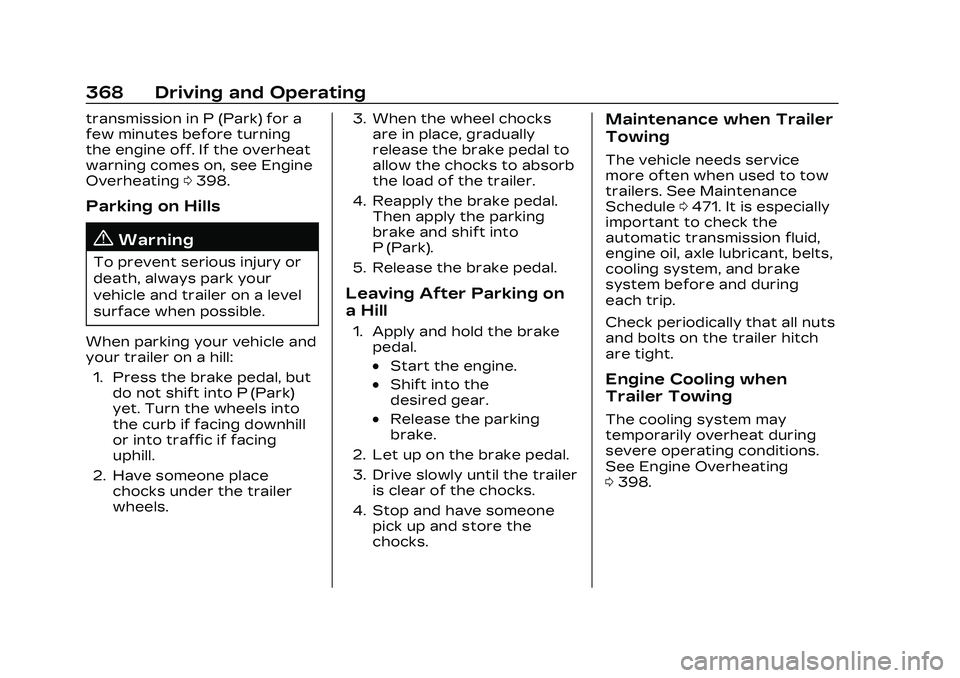
Cadillac CT5 Owner Manual (GMNA-Localizing-U.S./Canada-16500419) -
2023 - CRC - 5/10/22
368 Driving and Operating
transmission in P (Park) for a
few minutes before turning
the engine off. If the overheat
warning comes on, see Engine
Overheating0398.
Parking on Hills
{Warning
To prevent serious injury or
death, always park your
vehicle and trailer on a level
surface when possible.
When parking your vehicle and
your trailer on a hill: 1. Press the brake pedal, but do not shift into P (Park)
yet. Turn the wheels into
the curb if facing downhill
or into traffic if facing
uphill.
2. Have someone place chocks under the trailer
wheels. 3. When the wheel chocks
are in place, gradually
release the brake pedal to
allow the chocks to absorb
the load of the trailer.
4. Reapply the brake pedal. Then apply the parking
brake and shift into
P (Park).
5. Release the brake pedal.
Leaving After Parking on
a Hill
1. Apply and hold the brake pedal.
.Start the engine.
.Shift into the
desired gear.
.Release the parking
brake.
2. Let up on the brake pedal.
3. Drive slowly until the trailer is clear of the chocks.
4. Stop and have someone pick up and store the
chocks.
Maintenance when Trailer
Towing
The vehicle needs service
more often when used to tow
trailers. See Maintenance
Schedule 0471. It is especially
important to check the
automatic transmission fluid,
engine oil, axle lubricant, belts,
cooling system, and brake
system before and during
each trip.
Check periodically that all nuts
and bolts on the trailer hitch
are tight.
Engine Cooling when
Trailer Towing
The cooling system may
temporarily overheat during
severe operating conditions.
See Engine Overheating
0 398.
Page 374 of 526
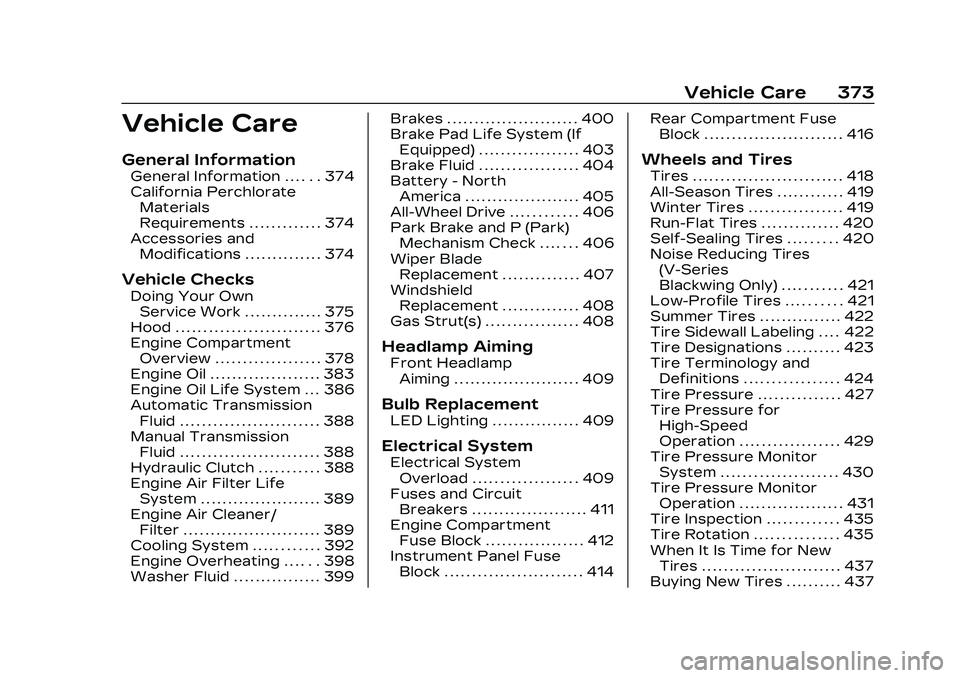
Cadillac CT5 Owner Manual (GMNA-Localizing-U.S./Canada-16500419) -
2023 - CRC - 5/6/22
Vehicle Care 373
Vehicle Care
General Information
General Information . . . . . . 374
California PerchlorateMaterials
Requirements . . . . . . . . . . . . . 374
Accessories and Modifications . . . . . . . . . . . . . . 374
Vehicle Checks
Doing Your OwnService Work . . . . . . . . . . . . . . 375
Hood . . . . . . . . . . . . . . . . . . . . . . . . . . 376
Engine Compartment Overview . . . . . . . . . . . . . . . . . . . 378
Engine Oil . . . . . . . . . . . . . . . . . . . . 383
Engine Oil Life System . . . 386
Automatic Transmission Fluid . . . . . . . . . . . . . . . . . . . . . . . . . 388
Manual Transmission Fluid . . . . . . . . . . . . . . . . . . . . . . . . . 388
Hydraulic Clutch . . . . . . . . . . . 388
Engine Air Filter Life System . . . . . . . . . . . . . . . . . . . . . . 389
Engine Air Cleaner/ Filter . . . . . . . . . . . . . . . . . . . . . . . . . 389
Cooling System . . . . . . . . . . . . 392
Engine Overheating . . . . . . 398
Washer Fluid . . . . . . . . . . . . . . . . 399 Brakes . . . . . . . . . . . . . . . . . . . . . . . . 400
Brake Pad Life System (If
Equipped) . . . . . . . . . . . . . . . . . . 403
Brake Fluid . . . . . . . . . . . . . . . . . . 404
Battery - North America . . . . . . . . . . . . . . . . . . . . . 405
All-Wheel Drive . . . . . . . . . . . . 406
Park Brake and P (Park) Mechanism Check . . . . . . . 406
Wiper Blade Replacement . . . . . . . . . . . . . . 407
Windshield Replacement . . . . . . . . . . . . . . 408
Gas Strut(s) . . . . . . . . . . . . . . . . . 408
Headlamp Aiming
Front Headlamp Aiming . . . . . . . . . . . . . . . . . . . . . . . 409
Bulb Replacement
LED Lighting . . . . . . . . . . . . . . . . 409
Electrical System
Electrical SystemOverload . . . . . . . . . . . . . . . . . . . 409
Fuses and Circuit Breakers . . . . . . . . . . . . . . . . . . . . . 411
Engine Compartment Fuse Block . . . . . . . . . . . . . . . . . . 412
Instrument Panel Fuse Block . . . . . . . . . . . . . . . . . . . . . . . . . 414 Rear Compartment Fuse
Block . . . . . . . . . . . . . . . . . . . . . . . . . 416
Wheels and Tires
Tires . . . . . . . . . . . . . . . . . . . . . . . . . . . 418
All-Season Tires . . . . . . . . . . . . 419
Winter Tires . . . . . . . . . . . . . . . . . 419
Run-Flat Tires . . . . . . . . . . . . . . 420
Self-Sealing Tires . . . . . . . . . 420
Noise Reducing Tires(V-Series
Blackwing Only) . . . . . . . . . . . 421
Low-Profile Tires . . . . . . . . . . 421
Summer Tires . . . . . . . . . . . . . . . 422
Tire Sidewall Labeling . . . . 422
Tire Designations . . . . . . . . . . 423
Tire Terminology and Definitions . . . . . . . . . . . . . . . . . 424
Tire Pressure . . . . . . . . . . . . . . . 427
Tire Pressure for High-Speed
Operation . . . . . . . . . . . . . . . . . . 429
Tire Pressure Monitor System . . . . . . . . . . . . . . . . . . . . . 430
Tire Pressure Monitor Operation . . . . . . . . . . . . . . . . . . . 431
Tire Inspection . . . . . . . . . . . . . 435
Tire Rotation . . . . . . . . . . . . . . . 435
When It Is Time for New Tires . . . . . . . . . . . . . . . . . . . . . . . . . 437
Buying New Tires . . . . . . . . . . 437
Page 380 of 526
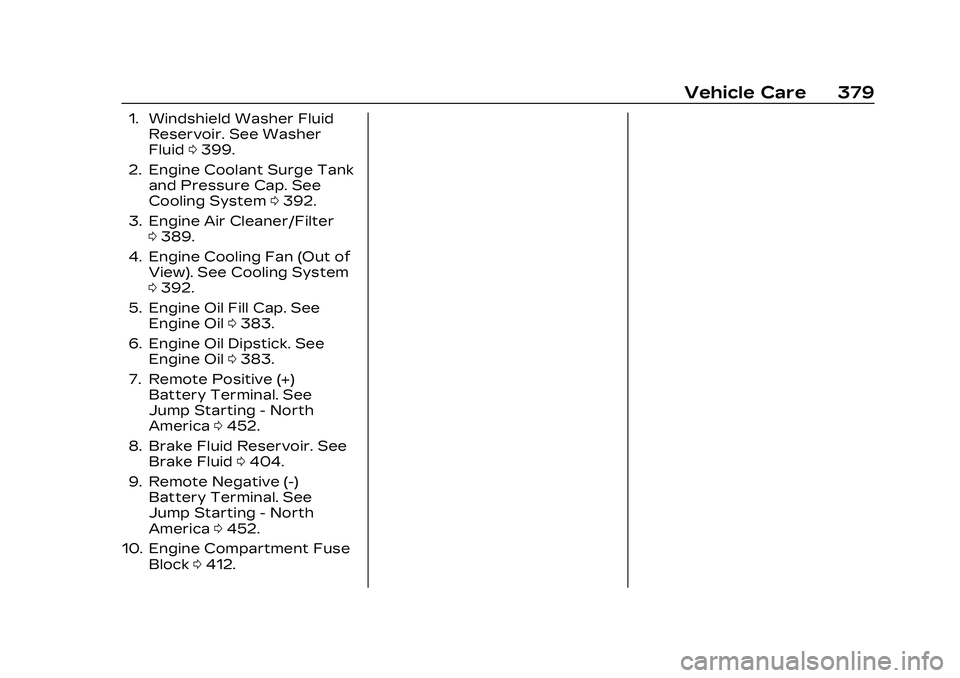
Cadillac CT5 Owner Manual (GMNA-Localizing-U.S./Canada-16500419) -
2023 - CRC - 5/6/22
Vehicle Care 379
1. Windshield Washer FluidReservoir. See Washer
Fluid 0399.
2. Engine Coolant Surge Tank and Pressure Cap. See
Cooling System 0392.
3. Engine Air Cleaner/Filter 0389.
4. Engine Cooling Fan (Out of View). See Cooling System
0392.
5. Engine Oil Fill Cap. See Engine Oil 0383.
6. Engine Oil Dipstick. See Engine Oil 0383.
7. Remote Positive (+) Battery Terminal. See
Jump Starting - North
America 0452.
8. Brake Fluid Reservoir. See Brake Fluid 0404.
9. Remote Negative (-) Battery Terminal. See
Jump Starting - North
America 0452.
10. Engine Compartment Fuse Block 0412.
Page 382 of 526
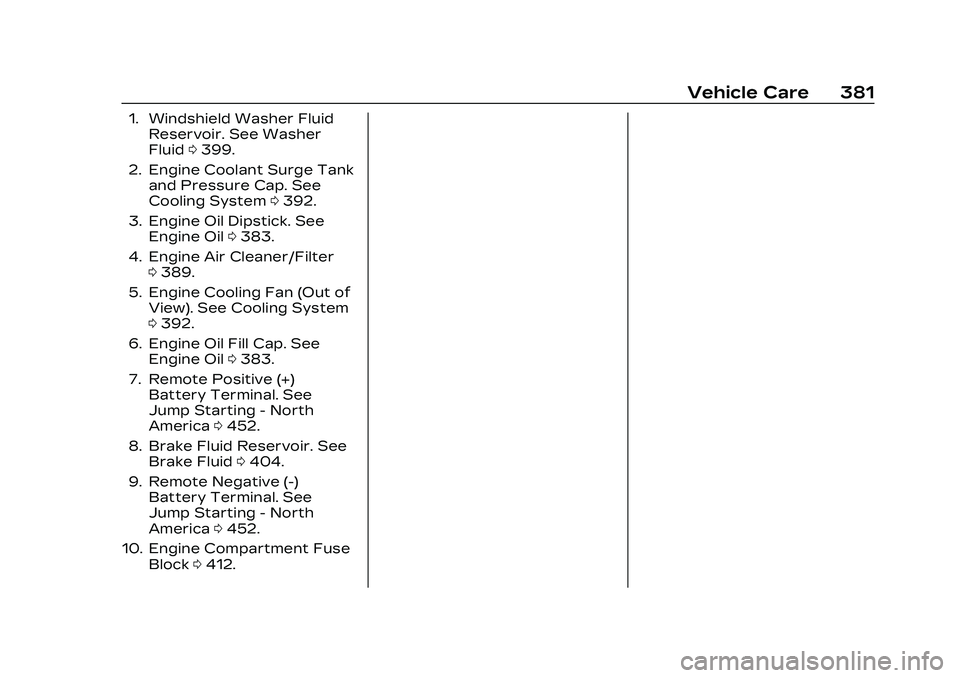
Cadillac CT5 Owner Manual (GMNA-Localizing-U.S./Canada-16500419) -
2023 - CRC - 5/6/22
Vehicle Care 381
1. Windshield Washer FluidReservoir. See Washer
Fluid 0399.
2. Engine Coolant Surge Tank and Pressure Cap. See
Cooling System 0392.
3. Engine Oil Dipstick. See Engine Oil 0383.
4. Engine Air Cleaner/Filter 0389.
5. Engine Cooling Fan (Out of View). See Cooling System
0392.
6. Engine Oil Fill Cap. See Engine Oil 0383.
7. Remote Positive (+) Battery Terminal. See
Jump Starting - North
America 0452.
8. Brake Fluid Reservoir. See Brake Fluid 0404.
9. Remote Negative (-) Battery Terminal. See
Jump Starting - North
America 0452.
10. Engine Compartment Fuse Block 0412.
Page 384 of 526
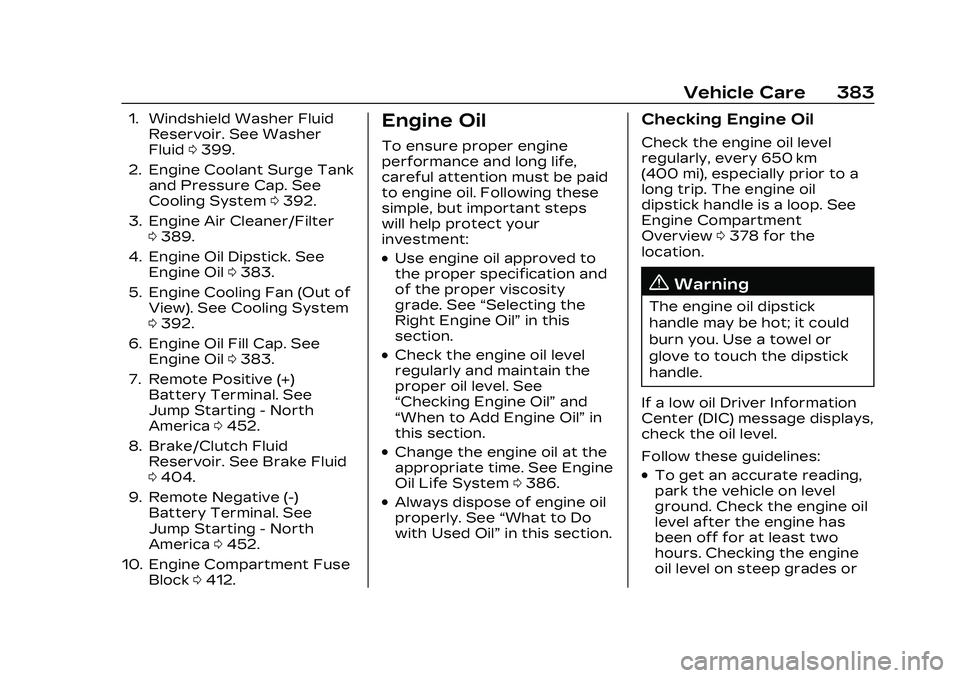
Cadillac CT5 Owner Manual (GMNA-Localizing-U.S./Canada-16500419) -
2023 - CRC - 5/6/22
Vehicle Care 383
1. Windshield Washer FluidReservoir. See Washer
Fluid 0399.
2. Engine Coolant Surge Tank and Pressure Cap. See
Cooling System 0392.
3. Engine Air Cleaner/Filter 0389.
4. Engine Oil Dipstick. See Engine Oil 0383.
5. Engine Cooling Fan (Out of View). See Cooling System
0392.
6. Engine Oil Fill Cap. See Engine Oil 0383.
7. Remote Positive (+) Battery Terminal. See
Jump Starting - North
America 0452.
8. Brake/Clutch Fluid Reservoir. See Brake Fluid
0404.
9. Remote Negative (-) Battery Terminal. See
Jump Starting - North
America 0452.
10. Engine Compartment Fuse Block 0412.Engine Oil
To ensure proper engine
performance and long life,
careful attention must be paid
to engine oil. Following these
simple, but important steps
will help protect your
investment:
.Use engine oil approved to
the proper specification and
of the proper viscosity
grade. See “Selecting the
Right Engine Oil” in this
section.
.Check the engine oil level
regularly and maintain the
proper oil level. See
“Checking Engine Oil” and
“When to Add Engine Oil” in
this section.
.Change the engine oil at the
appropriate time. See Engine
Oil Life System 0386.
.Always dispose of engine oil
properly. See “What to Do
with Used Oil” in this section.
Checking Engine Oil
Check the engine oil level
regularly, every 650 km
(400 mi), especially prior to a
long trip. The engine oil
dipstick handle is a loop. See
Engine Compartment
Overview0378 for the
location.
{Warning
The engine oil dipstick
handle may be hot; it could
burn you. Use a towel or
glove to touch the dipstick
handle.
If a low oil Driver Information
Center (DIC) message displays,
check the oil level.
Follow these guidelines:
.To get an accurate reading,
park the vehicle on level
ground. Check the engine oil
level after the engine has
been off for at least two
hours. Checking the engine
oil level on steep grades or